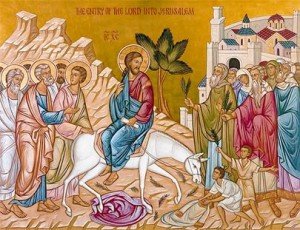 On this Willow Weekend, we use the Liturgy of St. John Chrysostom. The Liturgy of St. Basil the Great remains a part of the Great Lent or Fast. The Tropar for this feast has us pray:
On this Willow Weekend, we use the Liturgy of St. John Chrysostom. The Liturgy of St. Basil the Great remains a part of the Great Lent or Fast. The Tropar for this feast has us pray:
O Christ God, You confirmed the resurrection of all before the time of Your Passion by raising Lazarus from the dead: therefore we, like the children of Israel, carry the symbols of victory and cry out to You the Conqueror of death: Hosanna in the highest. Blessed is He who comes in the name of the Lord.
The Church reminds us that the Lord’s actions before His death and then His glorious resurrection after His burial, remind us that He, by His loving actions, has revealed to us that life is truly eternal and immortal and that bodily death is only the means that God has created to help us make a transition from this present life to the next stage of our eternal life. Jesus revealed this by raising Lazarus from the dead. He confirmed this fact by His own resurrection.
Our God, through these actions of His Son, desired to reveal to us the true meaning and purpose of this earthly life. There is a reason why we are here. Our lives are not just some sort of accident! Indeed we are given this earthly life to spiritually grow and to increase our awareness of the true nature of the life that we have been given. Human life is non-other-than a sharing in God’s own Divine Life. In fact, God’s life-force vivifies all of creation. His life-force calls all things into existence and maintains them in existence. This is what we are called to believe.
Some may find this hard to believe and resist committing themselves to this belief. While I realize that it cannot be empirically proven, it is a belief that gives a certain sense to this life. It also brings a deep sense to the worship (i.e., the Divine Liturgy) that we offer to the Father together with Jesus.
The Divine Liturgy confirms two very important things: (1) that our incarnate God, in the Person of Jesus, IS WITH US when we recall what He did on the night before He died; and (2) human life is a participation in God’s own life. The symbols of life, namely bread and wine which are representative of life, are CHANGED and TRANSFORMED into the very life of Jesus Himself. This is meant to be more than just symbolic. In truth, as we humbly receive the Body and Blood of Christ – Christ Himself – into our lives, we are transformed and radically changed – we become true children of God. Let us enter into this Great and Holy Week with this firm belief in our union with our God.
